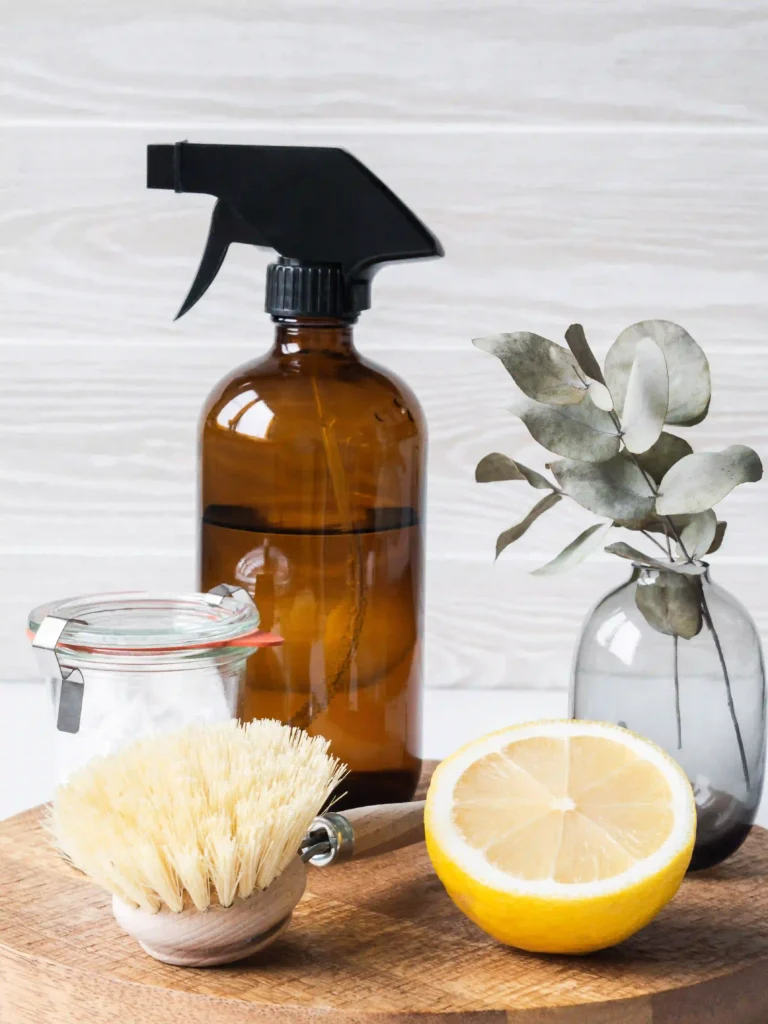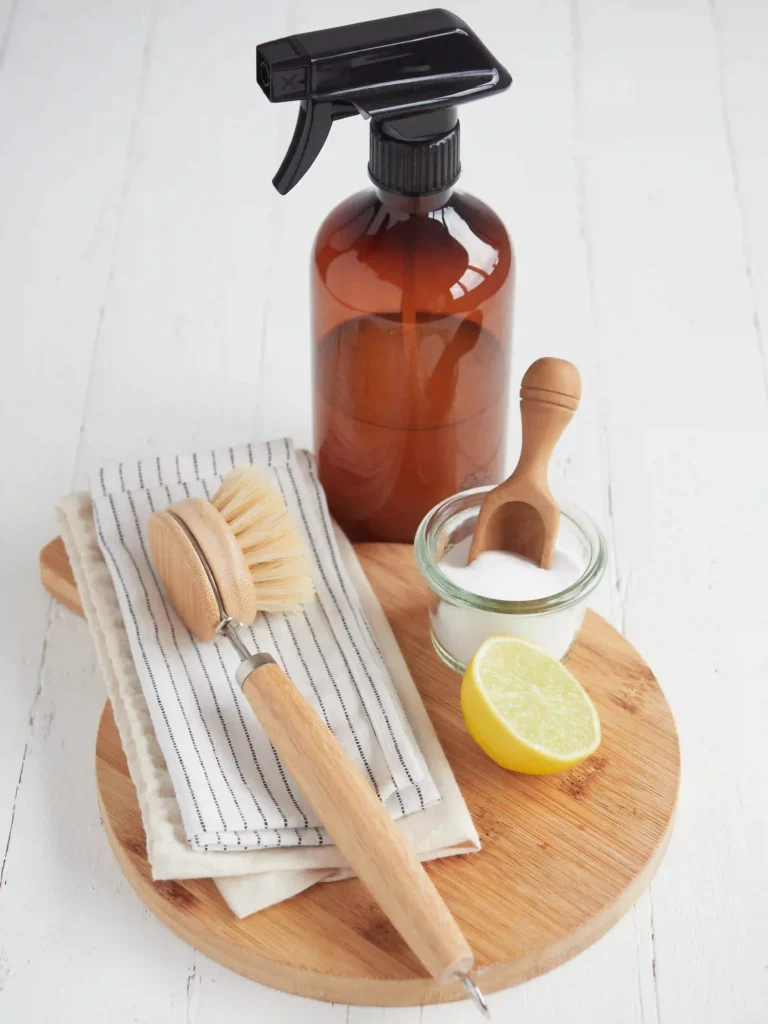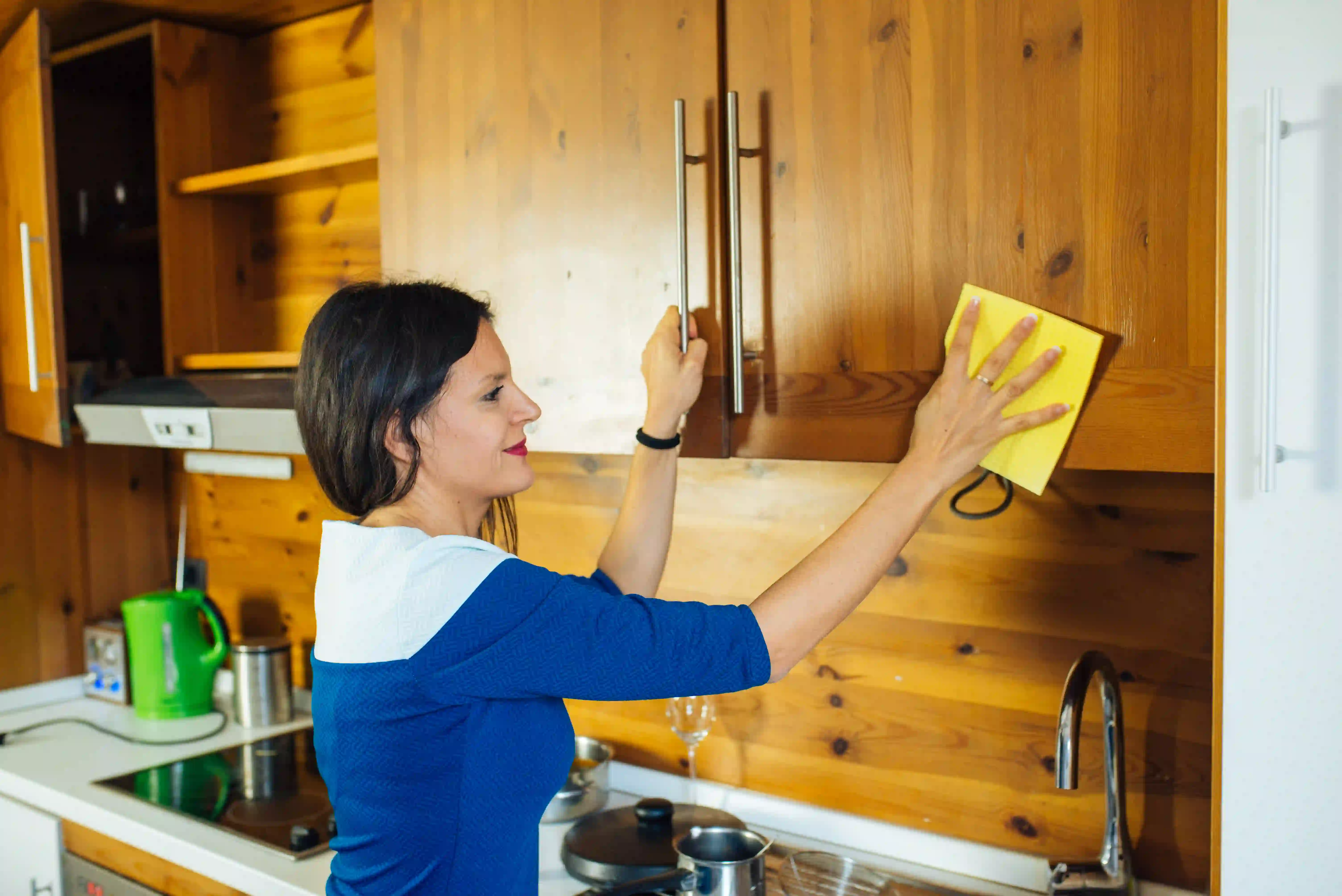Introduction
Have you ever wondered how to clean wood kitchen cabinets without leaving streaks or damaging the finish?
Grease and sticky fingerprints can make cabinets lose their shine if you don’t care for them. The good news is you don’t need harsh chemicals. With the right methods and a few household products, you can keep them looking great.
This guide will show you how to care for your wood cabinets, from daily cleaning to deep cleaning with natural methods.
Table of Contents
1. Why Cleaning Wood Cabinets Is Essential
Wood cabinets are a classic feature in kitchens, but without regular maintenance, grease, dust, and stains can build up quickly.
Keeping them clean helps preserve the wood grain, prevents warping, and extends the life of the cabinet finish. Clean cabinets also make your kitchen look brighter and more inviting.
2. How to Clean Wood Kitchen Cabinets Daily
For everyday cleaning, use a soft microfiber cloth to remove dust, crumbs, and fingerprints. A solution of mild dish soap and warm water works perfectly.
Wipe along the wood grain direction to avoid streaks, then dry with a clean cloth to prevent moisture damage.
Pro tip: Clean cabinet hardware like knobs and hinges regularly to prevent grime buildup.
3. How to Clean Wood Kitchen Cabinets with Grease Buildup
Grease can be tough to remove. For light grease, try mixing vinegar with warm water. If the buildup is heavier, make a paste with baking soda and water.
Gently use a soft sponge to scrub along the wood grain, then wipe clean with a damp cloth.
This method works especially well on grease stains around stoves and high-traffic cabinets.
4. Natural Ways to Clean Wood Cabinets (Eco-Friendly Options)
If you prefer natural cleaners:
- Lemon juice and olive oil: Cuts grease while restoring shine.
- White vinegar solution: Perfect for disinfecting and deodorizing.
- Baking soda paste: Great for sticky or stubborn spots.
These eco-friendly cleaners are non-toxic, safe for wood finishes, and prevent chemical damage.

5. How to Clean Wood Kitchen Cabinets Without Damaging the Finish
To protect your cabinet’s finish:
- Avoid harsh cleaners like bleach or ammonia.
- Never use abrasive pads—they scratch wood.
- Wipe spills immediately to prevent warping.
- Use wood polish or wax occasionally for extra protection.
This helps keep your lacquer, varnish, or polyurethane finish in good shape.
6. How to Remove Stains from Wood Cabinets
Sticky stains from sauces, coffee, or oils require a deeper clean. Use a gentle baking soda paste or a wood-safe cleaner.
Rub lightly in circles, rinse, and dry. For tough spots, apply a small amount of wood cleaner and repeat until the stain fades.
7. Best Products & Homemade Wood Cabinet Cleaners
If DIY isn’t enough, consider these trusted products:
- Murphy Oil Soap – gentle, effective for wood.
- Parker & Bailey Wood Cabinet Cream – restores shine.
- Method Wood Cleaner – eco-friendly and safe.
Homemade options include vinegar, baking soda, and olive oil mixes. These are budget-friendly and safe alternatives.

8. How to Clean Dark or Painted Wood Kitchen Cabinets
- Dark wood cabinets: Use gentle cleaners to avoid streaks. Dry thoroughly to prevent visible watermarks.
- Painted wood cabinets: Stick to mild dish soap and water. Avoid vinegar, as it may dull painted surfaces.
This way, your cabinets will keep their color and look great.
9. Preventing Damage: Cabinet Finish Protection Tips
- Avoid moisture exposure—never leave cabinets wet.
- Dust weekly to prevent buildup.
- Use wood conditioner or polish monthly to hydrate and protect the finish.
- Keep your kitchen ventilated to prevent humidity-related warping.
Taking these small steps will help your cabinets last longer.
10. Common Mistakes to Avoid When Cleaning Cabinets
- Overusing polish leaves sticky residue.
- Using abrasive pads or steel wool.
- Applying too much water can lead to swelling.
- Cleaning only the doors, but ignoring cabinet edges and corners.
By avoiding these mistakes, you can protect your wood cabinets from damage.
11. Maintenance Checklist for Long-Lasting Shine
✅ Wipe daily with a microfiber cloth
✅ Clean spills immediately
✅ Dust and polish monthly
✅ Deep clean with baking soda or vinegar every 3 months
✅ Inspect for scratches or worn finish regularly
Sticking to this schedule can help you avoid expensive repairs or refinishing later on.
12. Conclusion
Keeping your wood kitchen cabinets clean just takes a little consistency and care.
Whether you use eco-friendly options or special products, there are plenty of safe ways to get rid of grease, stains, and dust.
Clean along the wood grain, skip harsh chemicals, and look after the finish to keep your kitchen looking great for years.
FAQ’s
1. What is the best way to clean wood kitchen cabinets naturally?
Mix warm water with a little mild dish soap or vinegar for a natural clean. If you’re dealing with grease, try a baking soda paste. Wipe with a microfiber cloth and dry right away to protect the wood.
2. How do you clean greasy wood kitchen cabinets without damaging the finish?
Mix vinegar with warm water or make a gentle baking soda paste to clean greasy cabinets. Use a sponge and wipe along the wood grain, then rinse and dry. Stay away from abrasive pads or strong chemicals like bleach or ammonia.
3. Can I use vinegar to clean wood cabinets?
Yes, you can safely clean wood cabinets with vinegar mixed with warm water. It cuts grease and helps disinfect. Just avoid using vinegar on painted cabinets, since it can make the paint look dull over time.
4. How do I restore shine to my wood kitchen cabinets?
To bring back shine, try mixing olive oil with lemon juice or use a wood cabinet cream. Rub it on with a soft cloth and buff gently. Polishing once a month helps keep your cabinets looking shiny and protected.
5. How often should I deep clean wood kitchen cabinets?
Wipe down your cabinets daily or weekly for light cleaning. Every two to three months, do a deeper clean with baking soda, vinegar, or a wood-safe cleaner. This helps prevent grease and keeps your cabinets looking fresh.



